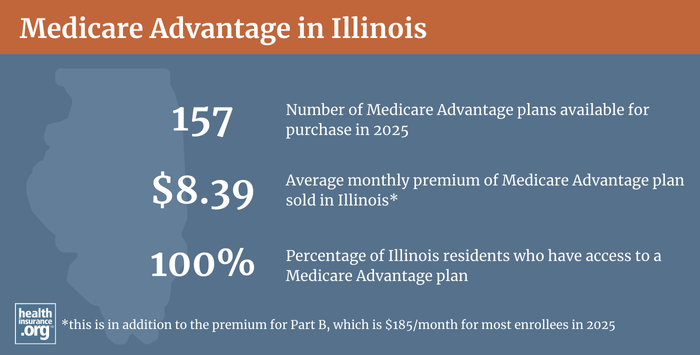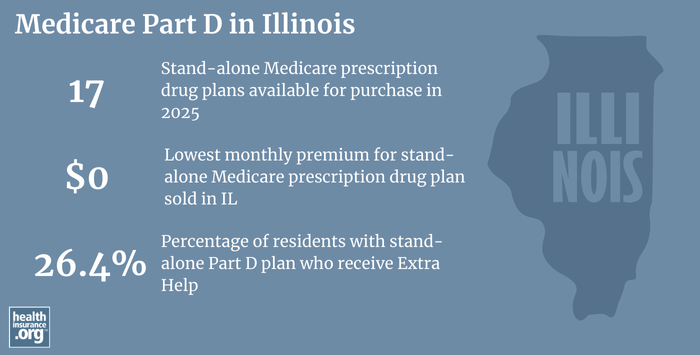Medicare in Illinois

Since the 1980s, Illinois has required Medigap insurers to cover beneficiaries under 65; New “birthday rule” window provides limited plan change options for some Medigap enrollees as of 2022
Key Takeaways
- More than 2.4 million residents are enrolled in Medicare in Illinois.1
- About 43% of Illinois Medicare beneficiaries are enrolled in private plans.1
- Illinois residents can select from among 17 stand-alone Part D prescription plans in 2025, with premiums starting at $0 per month.2

Medicare enrollment in Illinois
There were 2,403,206 Medicare beneficiaries in Illinois as of August 2024, amounting to almost 18% of the state’s population.13
Most beneficiaries are eligible for Medicare coverage because they’re at least 65 years old. But Medicare eligibility is also triggered when a person has been receiving disability benefits for two years, or has ALS or end-stage renal disease. Nationwide, about 11% of people enrolled in Medicare are under 65;4 in Illinois, it’s about 10%; the state has about 232,000Medicare beneficiaries who are under 65.1
Medicare’s annual election period (October 15 to December 7 each year) allows Medicare beneficiaries the opportunity to switch between Medicare Advantage plans and Original Medicare and/or add or drop a Medicare Part D prescription plan.
Medicare Advantage enrollees also have the option to change to a different Medicare Advantage plan or to Original Medicare during the Medicare Advantage open enrollment period, which runs from January 1 to March 31.
Learn about Medicare plan options in Illinois by contacting a licensed agent.



Explore our other comprehensive guides to coverage in Illinois

We’ve created this guide to help you understand the Illinois health insurance options available to you and your family, and to help you select the coverage that will best fit your needs and budget.


Hoping to improve your smile? Dental insurance may be a smart addition to your health coverage. Our guide explores dental coverage options in Illinois.


Learn about Illinois’ Medicaid expansion, the state’s Medicaid enrollment and Medicaid eligibility.


Short-term health plans provide temporary health insurance for consumers who may find themselves without comprehensive coverage. Learn more about short-term plan availability in Illinois.

Frequently asked questions about Medicare in Illinois
What is Medicare Advantage?
Although Medicare is funded and run by the federal government, enrollees can choose whether they want to receive their benefits directly from the federal government via Original Medicare or enroll in a Medicare Advantage plan offered by a private insurer, if such plans provide service in their area. There are pros and cons to Medicare Advantage and Original Medicare, and no single solution that works for everyone.
There are Medicare Advantage plans for sale throughout Illinois, with plan availability ranging from 1 plan to over 50 plans, depending on the county.5
43% of Medicare beneficiaries in Illinois were enrolled in Medicare Advantage plans as of August 2024.1

What are Medigap plans?
Original Medicare does not limit out-of-pocket costs, so most enrollees maintain some form of supplemental coverage. More than half of Original Medicare beneficiaries nationwide receive their supplemental coverage through an employer-sponsored plan or Medicaid. But for those who don’t, Medigap plans (also known as Medicare supplement plans) are designed to pay some or all of the out-of-pocket costs (deductibles and coinsurance) that Medicare beneficiaries would otherwise have to pay themselves.
Medigap plans are sold by private insurers, but the plans are standardized under federal rules, with ten different plan designs (differentiated by letters, A through N). The benefits offered by a particular plan (Plan C, Plan G, etc.) are the same regardless of which insurer is selling the plan. So plan comparisons are much easier for Medigap policies than for other types of health insurance; consumers can base their decision on premiums and less tangible things like customer service, since the benefits themselves are uniform.
There are 49 insurers that offer Medigap plans in Illinois for 2025, with premiums that vary depending on whether the person is in the Chicago area, the north-central area, or the southern area of the state.6
According to an AHIP analysis, there were 787,968 Illinois Medigap enrollees in 2020, so about half of the state’s Original Medicare population had Medigap coverage. This is higher than the rate in most states; nationwide, about a quarter of Original Medicare beneficiaries have Medigap coverage.
Unlike other private Medicare coverage (Medicare Advantage plans and Medicare Part D plans), there is no annual open enrollment window for Medigap plans. Instead, federal rules provide a one-time six-month window when Medigap coverage is guaranteed-issue. This window starts when a person is at least 65 and enrolled in Medicare Part B (you must be enrolled in both Part A and Part B to buy a Medigap plan). But Illinois has stronger consumer protections in this area than most other states: Illinois has long protected the right of beneficiaries under age 65 to enroll in Medigap (discussed below) and added a new limited annual enrollment window for some Medigap enrollees, which became available in 2022.
In 2021, Illinois enacted legislation that created a new Medicare Supplement Annual Open Enrollment Period (effective as of 2022). The annual enrollment opportunity is fairly limited, but it does still go beyond federal rules. Under the new Illinois law, Medigap enrollees between the ages of 65 and 75 have an annual window during which they can switch to a different Medigap plan, offered by their current Medigap insurer, as long as the plan offers equal or lesser benefits (so a person could switch from Plan F to Plan G, but not from Plan A to Plan G, for example). The window starts on the beneficiary’s birthday, and lasts for 45 days.
Additional legislation is under consideration in 2023 that would slightly expand the current birthday rule, allowing people to pick a plan with equal or lesser benefits from the same insurer or “any affiliate authorized to transact business” in Illinois. That would still be quite limited, but would allow access to a plan offered by an affiliate the person’s current insurer, rather than just the current insurer.
People who aren’t yet 65 can enroll in Medicare if they’re disabled and have been receiving disability benefits for at least two years, and 10% of Medicare beneficiaries in Illinois — about 232,000 people — are under 65 years old.1 Federal rules do not guarantee access to Medigap plans for people who are under 65, but the majority of the states, including Illinois, have enacted laws to ensure at least some access to private Medigap plans for disabled enrollees under the age of 65.
Illinois was one of the first to do so (see Illinois Insurance Code, Section 363). Since 1989, Illinois has required all Medigap insurers to sell policies to disabled Medicare beneficiaries. Medigap insurers must sell any of their available plans to beneficiaries under age 65, with a six-month guaranteed-issue window that starts when the person is enrolled in Medicare Part B (or when they are determined eligible for retroactive Medicare Part B coverage).
And while Medigap insurers in Illinois can charge an under-65 beneficiary higher premiums than they would charge a 65-year-old, beneficiaries under age 65 cannot be charged more than the insurer’s highest on-file rate for people over age 65. So a Medigap insurer could, for example, charge a 45-year-old the same premium they would charge an 85-year-old, but they cannot have an entirely separate set of under-65 rates that are higher than any of the age-based premiums for people over 65.
Illinois also goes a step beyond what many other states provide in terms of Medigap access for people under the age of 65: A disabled Medicare beneficiary who did not purchase a Medigap plan during their initial six-month enrollment window can buy a plan from Blue Cross Blue Shield of Illinois between October 15 and December 7 (although this is the same window during which Medicare beneficiaries have open access to Medicare Part D plans and Medicare Advantage plans, this is not a general open enrollment period for Medigap plans).
Blue Cross Blue Shield of Illinois also offers year-round guaranteed-issue coverage, regardless of medical history and at standard premiums, for people who are over the age of 65 and who are no longer in their initial enrollment period for Medigap. This is a fairly rare provision; most states do not have a year-round guaranteed-issue option for Medigap plans after a person’s initial enrollment period has closed.
As of 1999, a decade after Illinois began requiring Medigap insurers to offer plans to disabled beneficiaries under age 65, there were only 14 states with laws requiring Medigap insurers to offer even a single plan to people under age 65. Today, there are at least 33, although there are still several states that have made no provisions to ensure access to Medigap plans for disabled Medicare beneficiaries.
Although the Affordable Care Act eliminated pre-existing condition exclusions in most of the private health insurance market, those regulations don’t apply to Medigap plans. Medigap insurers can impose a pre-existing condition waiting period of up to six months, if you didn’t have at least six months of continuous coverage prior to your enrollment. And if you apply for a Medigap plan after your initial enrollment window closes (assuming you aren’t eligible for one of the limited guaranteed-issue rights), the insurer can look back at your medical history in determining whether to accept your application, and at what premium.
What is Medicare Part D?
Original Medicare does not cover outpatient prescription drugs. More than half of Original Medicare beneficiaries have supplemental coverage via an employer-sponsored plan or Medicaid, and these plans often include prescription coverage. But Medicare enrollees without creditable drug coverage need to obtain Medicare Part D prescription coverage. Medicare Part D plans can be purchased as a stand-alone plan, or as part of a Medicare Advantage plan that includes Part D prescription drug coverage.
Insurers in Illinois are offering 17 stand-alone Medicare Part D plans for sale in 2025, with premiums that start at $0/month.2
As of August 2024, more than 1.9 million Illinois Medicare beneficiaries had Medicare Part D coverage.1 About 50% of them had stand-alone Medicare Part D plans, while the rest had Medicare Advantage plans that included Part D coverage.1
Medicare Part D enrollment follows the same basic schedule as Medicare Advantage enrollment: Beneficiaries can pick a Part D plan when they’re first eligible for Medicare (or when they lose creditable drug coverage they had under another plan), or during the annual open enrollment period in the fall, from October 15 to December 7.

How does Medicaid provide financial assistance to Medicare beneficiaries in Illinois?
Many Medicare beneficiaries receive financial assistance through Medicaid with the cost of Medicare premiums, prescription drug expenses, and services Medicare doesn’t cover – such as long-term care.
Our guide to financial assistance for Medicare enrollees in Illinois includes overviews of these benefits, including Medicare Savings Programs, long-term care coverage, and eligibility guidelines for assistance.
What additional resources are available for Medicare beneficiaries and their caregivers in Illinois?
Need help with your Medicare application in Illinois, or Medicare eligibility in Illinois?
- You can contact the Illinois Senior Health Insurance Program with questions related to Medicare coverage in Illinois.
- The Illinois Department on Aging has an excellent resource for Illinois residents who are shopping for Medigap plans. Premiums varies by location, so there are three separate guides: Chicago Area, North-Central Area, and Southern Area.
- Illinois has a helpful handbook for state employees who are transitioning to Medicare.
- The Medicare Rights Center website provides helpful information geared to Medicare beneficiaries, caregivers, and professionals.
Louise Norris is an individual health insurance broker who has been writing about health insurance and health reform since 2006. She has written dozens of opinions and educational pieces about the Affordable Care Act for healthinsurance.org.

Looking for more information about other options in your state?
Need help navigating health insurance options in Illinois?
Explore more resources for options in Illinois including ACA coverage, short-term health insurance, dental insurance and Medicaid.
Speak to a sales agent at a licensed insurance agency.
Footnotes
- “Medicare Monthly Enrollment – Illinois.” Centers for Medicare & Medicaid Services Data. Accessed December, 2024. ⤶ ⤶ ⤶ ⤶ ⤶ ⤶ ⤶ ⤶
- ”Fact Sheet: Medicare Open Enrollment for 2025” (41) Centers for Medicare & Medicaid Services. Sep. 27, 2024 ⤶ ⤶
- U.S. Census Bureau Quick Facts: United States & Illinois.” U.S. Census Bureau, July 2023. ⤶
- “Medicare Monthly Enrollment – US” Centers for Medicare & Medicaid Services Data, December 2024. ⤶
- ”Medicare Advantage 2024 Spotlight: First Look” KFF.org Nov. 15, 2023 ⤶
- “Explore your Medicare coverage options.” Medicare.gov. Accessed October, 2024. ⤶

